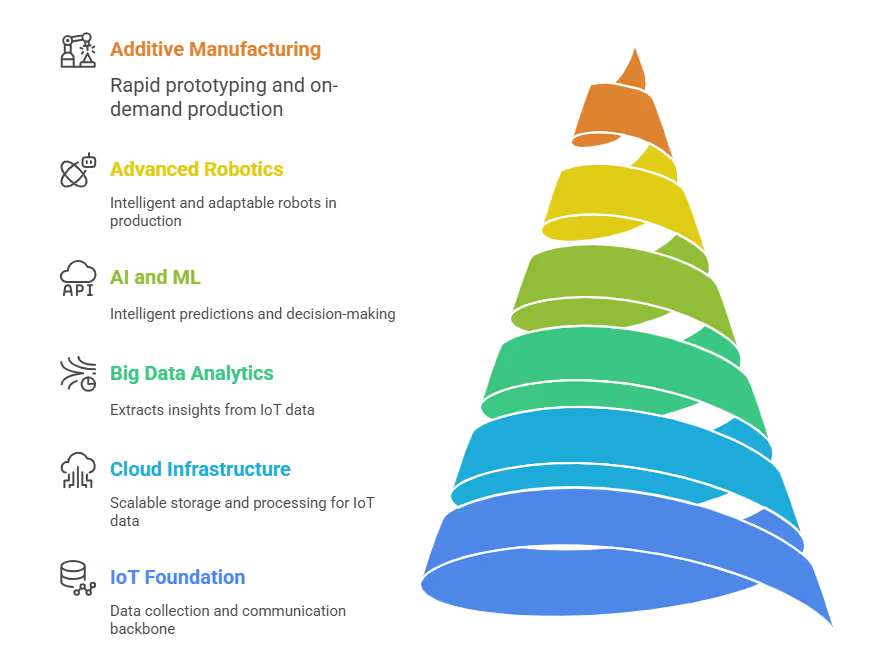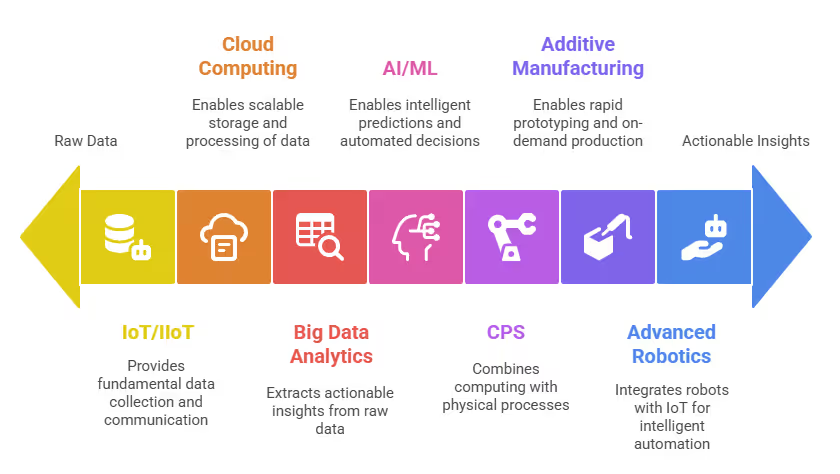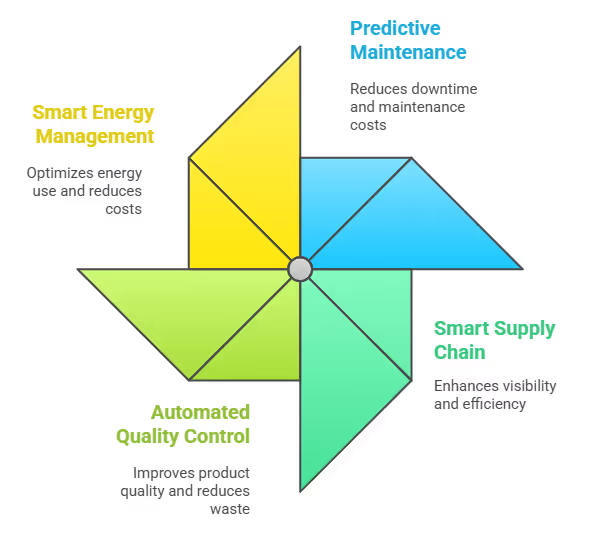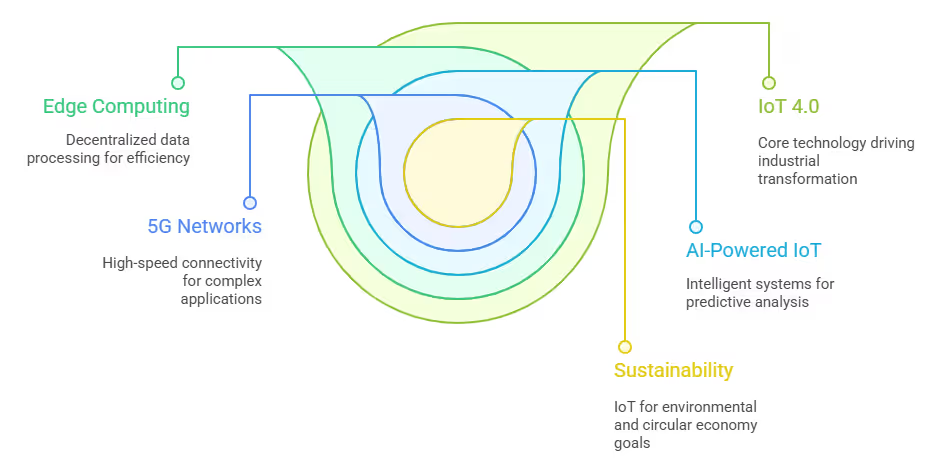Internet of Things in Industry 4.0: Why It Matters Now

IIoT 4.0 refers to the Industrial Internet of Things integrated within Industry 4.0, where connected machines, sensors, and data analytics optimize manufacturing processes. It enables factories to achieve real-time visibility, predictive maintenance, reduced downtime, and higher productivity. By combining IoT technology with smart manufacturing strategies, IIoT 4.0 transforms traditional factories into data-driven, efficient, and competitive operations.
IIoT 4.0 is redefining how U.S. manufacturers compete in today’s global market. If your factory faces unexpected downtime, rising operational costs, or lacks real-time visibility, you’re not alone. Manufacturers adopting Industrial Internet of Things (IIoT) solutions within Industry 4.0 are already achieving up to 20% higher production efficiency and cutting unplanned downtime by 35%.
This isn’t just an upgrade, it’s a digital revolution changing the DNA of modern factories.
At Hakuna Matata Tech, we’ve spent more than 15 years partnering with American businesses to implement advanced Product Engineering Services and Web App Development, seamlessly integrating IoT into their Industry 4.0 strategies.
In this blog, you’ll discover how IIoT 4.0 empowers manufacturers, the measurable benefits it delivers, and actionable solutions to real-world challenges.
The Internet of Things in Industry 4.0 helps U.S. manufacturers achieve unprecedented efficiency, cost savings, and innovation by connecting machines and data in real-time.

Table of Contents
- Understanding Industry 4.0 and the Power of IoT
- Solving Critical Problems for U.S. Manufacturers with IoT
- Real-World Impact: How IoT Transforms US Manufacturing
- The Business Case for IoT in U.S. Industry 4.0 Adoption
- Navigating the Future: Key Trends and Adoption Strategies for U.S. Manufacturers
- People Also Ask
Understanding Industry 4.0 and the Power of IoT
Industry 4.0 marks a pivotal shift in manufacturing. It represents the "smart factory" era, where digital and physical worlds merge. This transformation goes beyond simple automation; it focuses on seamless connectivity, immediate data exchange, and intelligent decision-making across the entire production lifecycle.
At its core, Industry 4.0 IoT refers to the Industrial Internet of Things (IIoT). This specifically applies IoT principles to industrial environments like manufacturing plants, energy facilities, and logistics operations. It involves a network of interconnected sensors, machines, and devices that collect and share vast amounts of data. This data then drives automation, optimization, and predictive insights.
Essential Components of Industry 4.0 Driven by IoT

- Cyber-Physical Systems (CPS): These intelligent systems combine computing power with physical processes, allowing for real-time interaction and autonomous control. Imagine smart robots on an assembly line communicating with each other and the central production system to optimize flow.
- The Internet of Things (IoT) / Industrial Internet of Things (IIoT): This is the fundamental layer. IoT devices provide critical data collection and communication from every machine, sensor, and asset on the factory floor and across the supply chain. Without robust IoT 4.0 connectivity, the smart factory cannot exist.
- Cloud Computing: The massive amounts of data generated by IoT Industry 4.0 devices require scalable storage and processing. Cloud platforms, like Amazon Web Services (AWS) or Microsoft Azure, provide the infrastructure to handle and analyze this data efficiently.
- Big Data Analytics: Raw data from IoT devices becomes valuable only when analyzed. Big data analytics tools extract actionable insights, allowing U.S. manufacturers to understand patterns, predict failures, and optimize operations.
- Artificial Intelligence (AI) and Machine Learning (ML): AI and ML algorithms learn from collected data, enabling machines to make intelligent predictions, automate complex decision-making, and continuously improve processes. A 2024 report by the National Institute of Standards and Technology (NIST) states that 67% of U.S. manufacturers plan to invest in IoT, AI, and digital twins in the next five years for real-time monitoring and predictive maintenance.
- Additive Manufacturing (3D Printing): This technology enables rapid prototyping and on-demand production, adding flexibility to the Industry 4.0 ecosystem.
- Advanced Robotics and Automation: Modern robots, often collaborating with human workers (cobots), are becoming more intelligent and adaptable through their integration with internet of things in industry 4.0 systems.
This powerful combination of technologies, with IoT and Industry 4.0 at its heart, empowers U.S. manufacturers to build truly intelligent, proactive, and responsive operations.
Solving Critical Problems for U.S. Manufacturers with IoT
Many U.S. manufacturers still grapple with common operational challenges that impact profitability and competitiveness.
We see these issues daily, and internet of things industry 4.0 provides direct, measurable solutions.

Problem 1: Unplanned Downtime and High Maintenance Costs
Unexpected machine breakdowns halt production, leading to missed deadlines and significant financial losses. Traditional maintenance is often reactive (fixing after a breakdown) or time-based (scheduled regardless of actual need), both of which are inefficient. A 2023 survey revealed that over a third of manufacturers (36%) acknowledge recurring difficulties in measuring operational efficiency and managing misplaced assets.
IoT Solution: Predictive Maintenance and Asset Optimization.
- How it works: We deploy IoT sensors on critical machinery, such as CNC machines or automated assembly lines, to continuously monitor parameters like vibration, temperature, and current draw. This data streams in real-time to an analytics platform.
- Real-world impact: For a major automotive parts plant in Michigan, implementing an IoT-driven monitoring system led to a 15% reduction in unplanned downtime within the first six months. By analyzing vibration and temperature data from critical machinery, their teams could intervene before catastrophic failures. Industry-wide, this approach has been shown to reduce maintenance costs by 20-40%, translating into substantial savings for U.S. manufacturing operations. This also extends the lifespan of expensive assets and ensures consistent production quality.
Problem 2: Lack of Real-Time Visibility Across the Supply Chain
Many U.S. companies struggle with opaque supply chains, leading to inefficient inventory management, delays, and an inability to quickly respond to disruptions. A 2023 survey highlighted that less than three-in-five manufacturers (59%) have achieved real-time visibility of production machinery, and only 58% for products or work in progress.
IoT Solution: Smart Supply Chain and Logistics Management.
- How it works: We implement IoT sensors and RFID tags on products, pallets, and shipping containers. These devices provide real-time location data and environmental conditions (temperature, humidity). This data feeds into a central dashboard, offering end-to-end visibility.
- Real-world impact: For an electronics manufacturer in Texas, deploying asset tracking sensors on high-value components significantly reduced inventory shrinkage and improved delivery times. This provided real-time location and condition data, optimizing logistics and reducing lead times, which is critical for both global IT buyers and domestic supply chains. For a large food processing company in California, IoT-enabled cold chain monitoring ensures product safety and reduces spoilage by constantly tracking temperatures inside refrigerated trucks, aligning with strict FDA regulations. This can reduce spoilage losses by potentially tens of thousands of dollars per shipment for large distributors.
Problem 3: Inconsistent Product Quality and High Waste
Variations in production parameters or late detection of defects lead to rework, scrap, and increased material waste, directly impacting profitability and sustainability goals.
IoT Solution: Automated Quality Control and Process Optimization.
- How it works: IoT-enabled cameras and sensors perform automated visual inspections, detecting defects and inconsistencies on the production line with greater speed and accuracy than manual checks. These systems also monitor critical manufacturing parameters like pressure, temperature, and flow rates.
- Real-world impact: We have deployed solutions where AI algorithms, fed by IoT 4.0 sensor data, identified subtle flaws in components with 99.98% accuracy, reducing scrap rates by up to 30% for a precision parts manufacturer in Ohio. By identifying inefficiencies and defects early, our clients have seen material waste and rework significantly reduced, leading to cost savings and more sustainable operations.
Problem 4: High Energy Consumption and Environmental Footprint
Energy costs are a major operational expense for U.S. manufacturers. Without precise monitoring, identifying and optimizing energy use is challenging, impacting both the bottom line and environmental compliance.
IoT Solution: Smart Energy Management.
- How it works: IoT sensors monitor energy usage at individual machine, production line, and entire facility levels. This granular data allows for detailed analysis of consumption patterns.
- Real-world impact: We have delivered projects where U.S. factories reduced their energy bills by 10-25% by leveraging IoT for smart energy management, contributing to both their financial bottom line and their sustainability goals. This also helps them meet increasingly stringent environmental regulations.
Real-World Impact: How IoT Transforms US Manufacturing
The integration of internet of things industry 4.0 is actively reshaping operations across various sectors in the United States.
From reducing downtime to enhancing product quality, the practical applications are vast and varied.
Predictive Maintenance and Asset Optimization
One of the most significant benefits of IoT in Industry 4.0 for U.S. manufacturers is the shift from reactive to proactive maintenance.
- Example: A major automotive manufacturer in Michigan implemented IoT sensors on its assembly line robots. The system continuously monitors the robots' motor vibrations. When an unusual vibration pattern is detected, it triggers an alert, allowing maintenance teams to schedule repairs during off-peak hours or before a critical failure, averting expensive shutdowns and maintaining production flow. This has led to a reported 20% reduction in unplanned outages for some manufacturers.
Enhanced Supply Chain Management and Logistics
IoT and Industry 4.0 extend beyond the factory floor, revolutionizing supply chain operations. Real-time visibility allows U.S. businesses to track materials, products, and equipment, leading to greater efficiency.
- Example: A large food processing company in California uses IoT-enabled cold chain monitoring for its perishable goods. Sensors inside refrigerated trucks continuously transmit temperature and humidity data, alerting the company to any deviations that could compromise product quality. This ensures compliance with food safety regulations and reduces spoilage, leading to better customer satisfaction and reducing losses by potentially tens of thousands of dollars per shipment for large distributors.
Quality Control and Process Optimization
The ability to collect and analyze real-time data from every stage of the production process dramatically improves quality control and allows for continuous process optimization.
- Example: A semiconductor fabrication plant in Arizona utilizes Industry 4.0 and IoT for real-time monitoring of its cleanroom environment and wafer production. Any particle contamination or temperature fluctuations are immediately detected, preventing defects and ensuring the integrity of sensitive components. This has led to a reported 99.98% product quality output in similar applications, significantly reducing costly scrap.
Worker Safety and Environmental Monitoring
IoT solutions also play a crucial role in enhancing worker safety and monitoring environmental conditions within industrial facilities.
- Example: At a chemical processing plant in Louisiana, we deployed IoT gas sensors that continuously monitor air quality. If a dangerous gas leak is detected, the system immediately alerts safety personnel and automatically triggers ventilation systems, significantly reducing the risk of accidents and ensuring compliance with OSHA safety standards.
The Business Case for IoT in U.S. Industry 4.0 Adoption
The benefits of integrating internet of things in industry 4.0 translate directly into significant returns on investment for U.S. businesses. The market itself is booming; the United States Industry 4.0 market size was valued at USD 19.23 billion in 2024 and is projected to grow to USD 50.80 billion by 2033, exhibiting a CAGR of 11.4%.
This growth is driven by clear economic advantages.
Increased Efficiency and Productivity
By automating data collection, enabling real-time monitoring, and facilitating predictive analytics, IoT Industry 4.0 solutions dramatically enhance operational efficiency.
- Optimized Resource Utilization: Real-time data on energy consumption, material usage, and machine performance allows for precise adjustments, minimizing waste and maximizing output.
- We've seen clients reduce material waste by over 20% in just six months.
Cost Reduction and ROI
The investments in IoT and Industry 4.0 technologies, while substantial upfront, lead to significant long-term cost savings.
- Lower Operational Expenses: Optimized energy consumption, reduced waste, and improved labor efficiency all contribute to lower overall operating costs.
- Improved Quality, Less Rework: Catching defects early and maintaining consistent quality reduces scrap rates and the need for expensive rework, potentially leading to a 30-35% reduction in rejection rates.
Enhanced Agility and Competitiveness
The ability to adapt quickly is a key differentiator. Industry 4.0 and IoT empower U.S. manufacturers with this agility.
- Faster Time to Market: Streamlined processes and improved production efficiency accelerate product development and delivery. For example, some companies adopting Generative AI Chatbots for internal knowledge management have reported a 15% faster information retrieval for engineers, speeding up design cycles.
- New Business Models: Insights from IoT data enable new service-oriented models, such as "product-as-a-service," where companies sell uptime or performance rather than just the physical product. This is a key aspect of the Internet of Services Industry 4.0.
Navigating the Future: Key Trends and Adoption Strategies for U.S. Manufacturers
The future of IoT 4.0 in the United States is rapidly evolving, bringing new opportunities and complexities.
To remain at the forefront, U.S. manufacturers must understand and strategically adopt emerging trends.

Trend 1: The Rise of Edge Computing
As industrial IoT deployments expand, processing data at the "edge" – directly on the factory floor – becomes crucial.
The global edge computing market is projected to reach over $60 billion by 2027.
- Why it matters: Edge computing reduces latency, processes critical data closer to the source, and enhances security by minimizing data transfer to the cloud. This is especially vital for real-time control systems in manufacturing, where milliseconds can impact production.
- Adoption Strategy: U.S. manufacturers should invest in edge gateways and computing devices capable of processing data locally. This can include specialized industrial PCs or even intelligent sensors with built-in processing capabilities. Prioritize solutions that integrate seamlessly with existing cloud platforms for aggregated data analysis and long-term storage.
Trend 2: Advanced AI-Powered IoT and Digital Twins
The fusion of Artificial Intelligence with IoT will become even more sophisticated, with digital twins at the forefront.
The global digital twin market is expected to reach $110.1 billion by 2030.
- Why it matters: Digital twins, virtual replicas of physical assets or entire factory floors, leverage real-time Internet of Things in Industry 4.0 data and AI for highly accurate simulations, predictive modeling, and optimization. For example, companies like General Electric (GE) and Siemens use digital twins to simulate maintenance scenarios or optimize production lines before implementing changes in the physical world, leading to significant cost savings and reduced risks.
- Adoption Strategy: Begin by creating digital twins for critical assets or processes. This requires a robust data collection strategy using IoT sensors, combined with advanced analytics and AI platforms. Focus on specific use cases, such as predicting equipment lifespan or optimizing energy flow, to demonstrate early value before expanding.
Trend 3: The Impact of 5G and Private Networks
The widespread deployment of 5G networks in the U.S. provides the necessary infrastructure for dense IoT deployments.
The market for private 5G networks in manufacturing is predicted to grow significantly, reaching an estimated $10 billion by 2028.
- Why it matters: 5G offers high bandwidth, ultra-low latency, and massive connectivity, essential for supporting complex IoT applications like autonomous mobile robots, real-time machine vision systems, and remote-controlled machinery. Private 5G networks offer enhanced security, reliability, and dedicated bandwidth within a factory, making them ideal for mission-critical industrial applications.
- Adoption Strategy: Evaluate the connectivity needs of your specific industrial IoT applications. For highly critical or data-intensive operations, explore the feasibility of deploying a private 5G network. For broader coverage and less latency-sensitive applications, leverage public 5G infrastructure. Partnerships with telecommunication providers and IoT development companies are crucial here.
Trend 4: Sustainability and Circular Economy Integration
IoT Industry 4.0 solutions will increasingly be vital for achieving sustainability goals and enabling circular economy practices.
For instance, the IoT in the global energy market is expected to grow to $35.2 billion by 2025.
- Why it matters: Real-time monitoring of energy consumption, waste generation, and emissions allows manufacturers to optimize their environmental footprint, comply with regulations, and reduce resource consumption. IoT can also enable better tracking of product lifecycles, supporting recycling and reuse initiatives.
- Adoption Strategy: Implement IoT sensors for granular energy monitoring across all operations. Utilize data analytics to identify areas of high waste or energy inefficiency. Explore how IoT can facilitate traceability for raw materials and finished products, supporting remanufacturing and recycling programs.


